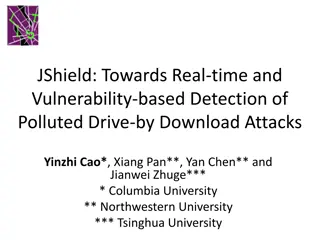Types Cyber Attacks: Cyber Security Training Workshop
Join our Cyber Security Training Workshop to learn about different types of cyber attacks such as social engineering attacks, DDoS attacks, malware attacks, MitM attacks, APTs, and password attacks. Enhance your knowledge and skills in cyber security.
15 views • 45 slides
Adversarial Machine Learning
Evasion attacks on black-box machine learning models, including query-based attacks, transfer-based attacks, and zero queries attacks. Explore various attack methods and their effectiveness against different defenses.
21 views • 60 slides
Adversarial Machine Learning in Cybersecurity: Challenges and Defenses
Adversarial Machine Learning (AML) plays a crucial role in cybersecurity as security analysts combat continually evolving attack strategies by malicious adversaries. ML models are increasingly utilized to address the complexity of cyber threats, yet they are susceptible to adversarial attacks. Inves
1 views • 46 slides
Understanding Malicious Attacks, Threats, and Vulnerabilities in IT Security
Malicious attacks, threats, and vulnerabilities in IT systems pose significant risks and damages. This chapter explores the types of attacks, tools used, security breaches, and measures to protect against cyber threats. Learn how security professionals safeguard organizations from malicious attacks
0 views • 24 slides
Role of AI in Threat Detection and Zero-day Attacks
Cybercrime has been on the rise, especially with the surge in zero-day attacks targeting various industries. State-sponsored actors, like Chinese groups, dominate zero-day exploits, challenging traditional detection methods. Incorporating AI, machine learning, and deep learning is vital in enhancing
0 views • 9 slides
Principles of Cyber Security
Threat actors prioritize targeting networks to exploit vulnerabilities, leading to various attacks such as interception, DNS attacks, and MITM attacks. MITM attacks involve eavesdropping on communications or impersonating parties, with techniques like session replay to steal credentials. Implementin
0 views • 7 slides
Understanding Phishing Attacks: Risks, Prevention, and Awareness
Phishing attacks are prevalent cybercrimes where attackers deceive individuals into divulging sensitive information or engaging in harmful actions. These attacks can happen through various channels such as emails, texts, or websites. The perpetrators aim to manipulate emotions like curiosity, greed,
1 views • 47 slides
Managing Covid-19 Cyber and Data Protection Risks
Exploring the risks and challenges related to cyber attacks and data protection amidst the Covid-19 pandemic. The agenda covers an overview of cyber-attacks, recent developments, protections against cyber attacks, data protection concerns during lockdown, compliance steps, and employee rights issues
1 views • 35 slides
Mitigation of DMA-based Rowhammer Attacks on ARM
Practical strategies are presented in "GuardION: Practical Mitigation of DMA-based Rowhammer Attacks on ARM" to defend against Rowhammer attacks on ARM architecture. The paper discusses Rowhammer defenses, RAMPAGE attacks on Android OS, and introduces GuardION as a lightweight mitigation approach. I
0 views • 48 slides
Cybersecurity Challenges: Attacks on Web Applications and Cost of Security Breaches
In the realm of cybersecurity, attacks on web applications pose a significant threat with 78% of attacks targeting applications. The consequences of these attacks are immense, with projected costs reaching $6 trillion annually by 2021. Notable breaches in recent years highlight the urgency for robus
8 views • 23 slides
Rogue MPDU Detection in RSNA Issues and Solutions
Abstract CIDs highlighted issues related to valid MPDUs not being acknowledged due to malicious attacks in RSNA. Efforts were made to enhance security using Protected Block Ack, but vulnerabilities persist. Various solutions are being explored, and input from group members is sought to find the best
2 views • 12 slides
Understanding Denial-of-Service Attacks and Defense Strategies
Denial-of-Service attacks pose a serious threat where attackers flood networks with traffic, leading to system crashes and slowdowns. Explore the impact, expected results, and various categories of DoS attacks such as bandwidth attacks, protocol exceptions, and logic attacks. Learn how to defend aga
0 views • 61 slides
Understanding Network Denial of Service (DoS) Attacks
Network Denial of Service (DoS) attacks aim to disrupt services by overwhelming them with traffic. These attacks can occur at various layers of the network stack and exploit weaknesses to achieve their goal. Amplification attacks, such as the Smurf attack and DNS Amplification attack, can significan
2 views • 52 slides
Preventing Active Timing Attacks in Low-Latency Anonymous Communication
This research addresses the vulnerabilities of onion routing to timing attacks and proposes solutions to prevent active timing attacks, focusing on low-latency anonymous communication systems. Various problems related to timing attacks in onion routing are analyzed, including the role of adversaries
0 views • 52 slides
Understanding Malicious Software and Its Impact on Computer Systems
Malicious software, commonly known as malware, poses a serious threat to computer systems by exploiting vulnerabilities. This content covers various terminologies, categories, and types of malware, including viruses, worms, rootkits, spyware, and adware. It also delves into how malware can cause dam
0 views • 16 slides
Understanding Control Hijacking Attacks in Software Systems
Control hijacking attacks, such as buffer overflows and format string vulnerabilities, allow attackers to take over a target machine by manipulating application control flow. Knowledge of C functions, system calls, CPU, and OS used is crucial for executing these attacks successfully. This summary pr
1 views • 55 slides
Understanding Control Hijacking Attacks and Defenses
Control hijacking attacks pose a significant threat by allowing malicious actors to manipulate data and control flow within a system. This article explores common attack methods like stack smashing and heap spraying, along with defenses such as fixing bugs, implementing platform defenses, and markin
1 views • 36 slides
Investigating Add-On Cross Site Scripting Attacks: Abusing Browser Address Bar
This presentation delves into the realm of add-on cross site scripting attacks, exploring real-world examples and effects on popular social media platforms like Facebook and Twitter. The experiments conducted shed light on malicious behaviors, deceptive techniques, and potential severe consequences
0 views • 27 slides
Understanding BGP and DNS Worms in Network Security
Border Gateway Protocol (BGP) is crucial for network communication, allowing autonomous systems to exchange routing information. BGP works by announcing network ownership and directing traffic efficiently. However, BGP Blackhole attacks pose a threat, where malicious entities reroute traffic to disr
0 views • 37 slides
Strategies to Protect School Systems from Cyber Attacks
Schools are increasingly becoming targets of cyber attacks, making cybersecurity measures crucial. The article discusses the importance of responding to cyber attacks, creating incident response plans, and being vigilant against interception attacks. It outlines the steps to detect, document, and mi
0 views • 21 slides
Understanding Heap Overflow Attacks
A heap is a collection of variable-size memory chunks managed by the program. Heap overflow attacks occur when malicious actors corrupt heap memory, potentially allowing them to overwrite data and execute arbitrary code. This poses a significant security risk. The process involves manipulating heap
2 views • 19 slides
Protecting Your Business from Cybersecurity Threats
In today's digital landscape, the risk of cyber attacks is higher than ever. Hackers offer malicious services for a low cost, increasing the threat of ransomware, phishing, and spam attacks. With statistics showing the rise in ransomware incidents, it's crucial for organizations to prioritize securi
0 views • 24 slides
Understanding Authentication Mechanisms and Security Vulnerabilities
Authentication lies at the core of application security, serving as the primary defense against malicious attacks. This article explores various authentication technologies, including HTML forms-based authentication, multi-factor mechanisms, client SSL certificates, and more. It delves into common d
0 views • 70 slides
Understanding Privilege Escalation in Windows and Linux Systems
Privilege escalation attacks are malicious tactics used by attackers to gain unauthorized access and elevated privileges in a system. These attacks exploit vulnerabilities in operating systems and web applications, allowing attackers to move deeper into a network to access high-value assets. This co
0 views • 28 slides
Understanding Unix/Linux Hacking Techniques
Explore Unix/Linux hacking techniques including footprinting, scanning, enumeration, vulnerability mapping, remote access, data-driven attacks, buffer overflow, input validation, and countermeasures. Discover methods to gain root access, exploit vulnerabilities, perform brute force attacks, and secu
0 views • 6 slides
Real-Time Detection of Polluted Drive-by Download Attacks with JShield
Protecting against drive-by download attacks, JShield offers a real-time, vulnerability-based detection system that identifies malicious JavaScript samples. With a focus on mitigating sample pollution and evasive tactics, this innovative approach has been implemented by a leading telecommunications
0 views • 24 slides
Detecting Drive-By Attacks: Analysis of Malicious Javascript in Big Data Environments
Cybersecurity researcher Andrei Bozeanu delves into the complex world of polymorphic viruses, heuristic analysis, and the similarities between polymorphic viruses and malicious Javascript. Discover how these threats operate and evade detection, highlighting the importance of understanding malware be
0 views • 48 slides
Automated Signature Extraction for High Volume Attacks in Cybersecurity
This research delves into automated signature extraction for high-volume attacks in cybersecurity, specifically focusing on defending against Distributed Denial of Service (DDoS) attacks. The study discusses the challenges posed by sophisticated attackers using botnets and zero-day attacks, emphasiz
0 views • 37 slides
Proactive Security Measures in Wireless Network Design
Exploring the benefits of proactive security measures in wireless networks, this study delves into protecting network flow information from inference attacks and implementing security designs to prevent eavesdropping. Case studies, strategies to safeguard connectivity information, and methods for un
0 views • 53 slides
Targeted Deanonymization via the Cache Side Channel: Attacks and Defenses
This presentation by Abdusamatov Somon explores targeted deanonymization through cache side-channel attacks, focusing on leaky resource attacks and cache-based side-channel attacks. It discusses the motivation behind these attacks, methods employed, potential defenses, and the evaluation of such att
0 views • 16 slides
Understanding Network Security Vulnerabilities and Attacks
Explore the world of network security vulnerabilities and attacks, including Denial-of-Service (DoS) and Distributed-Denial-of-Service (D-DoS), security flaws in the TCP/IP protocol suite, ICMP attacks, routing attacks, and TCP attacks. Learn about common security vulnerabilities such as address spo
0 views • 36 slides
Buffer Overflow Attack and Vulnerable Programs
Understanding buffer overflow attacks and vulnerable programs, the consequences of such attacks, how to run malicious code, and the setup required for exploiting vulnerabilities in program memory stack layouts. Learn about creating malicious inputs (bad files), finding offsets, and addressing shellc
0 views • 36 slides
Understanding Network Interference in CS590B/690B Lecture
Delve into the realm of network interference through the CS590B/690B lecture with Phillipa Gill at UMass Amherst. Explore topics such as Internet routing, timing attacks, BGP hijacks, Tor network functionality, relay selection, collusion scenarios, use of guards, web site fingerprinting attacks, tra
0 views • 11 slides
Transitioning to BGP Security: Incentives and Challenges
Explore the strategies and incentives for transitioning to BGP security in internet routing, including the use of S*BGP to attract traffic and mitigate interception attacks. Learn about RPKI as a key infrastructure and the need for additional security measures beyond RPKI. Discover how S*BGP can hel
0 views • 31 slides
Machine Learning for Cybersecurity Challenges: Addressing Adversarial Attacks and Interpretable Models
In the realm of cybersecurity, the perpetual battle between security analysts and adversaries intensifies with the increasing complexity of cyber attacks. Machine learning (ML) is increasingly utilized to combat these challenges, but vulnerable to adversarial attacks. Investigating defenses against
0 views • 41 slides
Understanding Malicious Software: Classification and Payload Actions
Malicious software, or malware, can be broadly classified based on how it spreads and the actions it performs once on a target system. This classification includes distinctions between viruses, worms, trojans, botnets, and blended attacks. The payload actions of malware can range from file corruptio
0 views • 44 slides
Understanding Cross-Site Scripting (XSS) Attacks and Prevention Measures
Cross-Site Scripting (XSS) is a prevalent security vulnerability in web applications that allows attackers to inject malicious scripts, potentially leading to unauthorized data access or manipulation. The content covers types of XSS attacks, finding vulnerable websites, testing exploits, and legal i
0 views • 10 slides
Understanding DDoS Attacks: Simulation, Analysis & Defense
Delve into the world of Distributed Denial of Service (DDoS) attacks with this comprehensive study covering the architecture, advantages, bot installation phases, attack methods, defenses, and simulation. Learn about the detrimental impact of DDoS attacks on servers, their multi-tiered structure, an
0 views • 20 slides
Understanding Cross-Site Scripting (XSS) Attacks
Learn about the dangers of Cross-Site Scripting (XSS) attacks, including Reflected and Persistent XSS types. This malicious practice allows attackers to inject harmful code into websites, potentially compromising user data and security measures. Discover how XSS attacks work, their impact on online
0 views • 38 slides
Overview of DoS and DDoS Attacks in Cybersecurity
This content provides an in-depth overview of Denial of Service (DoS) and Distributed Denial of Service (DDoS) attacks in cybersecurity. It covers the types of attacks, including volumetric, reflected, and stealthy, along with detailed explanations and examples. Additionally, it discusses how DoS at
0 views • 8 slides







































